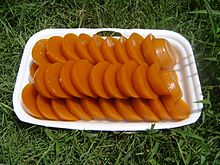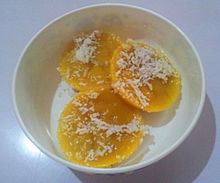Kutsinta facts for kids
  |
|
| Alternative names | Kutsinta, Kuchinta, Kutchinta |
|---|---|
| Type | Rice cake |
| Course | Dessert, merienda, or snack |
| Place of origin | Philippines |
| Serving temperature | Room temperature |
| Main ingredients | Tapioca or Rice flour, brown sugar, lye, grated coconut meat |
| Similar dishes | Mont kywe the, kuih kosui |
Kutsinta (also spelled cuchinta) is a popular, chewy rice cake from the Philippines. It's a type of puto, which means "steamed cake." You can find kutsinta all over the Philippines, and it's a favorite snack for many people.
This sweet treat is made from a mix of special ingredients. These include tapioca or rice flour, brown sugar, and a small amount of lye. Lye is a special ingredient that helps give kutsinta its unique jelly-like and chewy texture. Sometimes, yellow food coloring or annatto extract is added to give it a bright, appealing color. The mixture is then steamed in small molds until it's perfectly cooked.
Contents
What is Kutsinta?
Kutsinta is a delicious rice cake that's different from other steamed cakes. While some rice cakes are soft and doughy, kutsinta has a special texture. It's very chewy and feels a bit like jelly. This makes it a fun and unique snack to eat.
People in the Philippines enjoy kutsinta all year round. It's often eaten as a merienda, which is like a snack between meals. You'll often see it sold alongside other types of puto. To make it even tastier, kutsinta is usually topped with fresh, grated coconut meat. Sometimes, people also add latik (a sweet coconut syrup) or even grated cheese or a creamy yema sauce for extra flavor.
How is Kutsinta Made?
Making kutsinta involves a few simple steps. It's a fun process that turns basic ingredients into a yummy treat.
Ingredients and Mixing
First, brown sugar is melted and mixed with a small amount of lye water. This lye water is important for the cake's texture. Then, glutinous rice flour and regular rice flour are added to the mixture. Everything is stirred very well until all the ingredients are completely dissolved and there are no lumps. Sometimes, a little red liquid food coloring is added to give the kutsinta its traditional orange-brown color.
Steaming the Cakes
Before steaming, small molds are lightly brushed with vegetable oil. This stops the kutsinta from sticking. The mixture is then poured into these molds. They are placed in a steamer and cooked until the top of the cake feels firm when gently touched.
Cooling and Serving
Once cooked, the kutsinta molds are removed from the heat. It's important to let them cool down completely before taking the cakes out. A spatula can be used to carefully remove them from the molds. Finally, the kutsinta is ready to be enjoyed! It's usually topped with fresh, grated coconut or served with a side of coconut for dipping.

